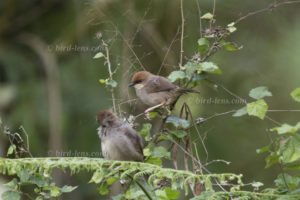 Arriving from the Northern Extension of the Rockjumper Rainforest & Rockfowl 2017 – tour we were more than tired as we had arrived on a late flight from Garoua via Yaoundé. To postpone the breakfast to get some sleep was not advisable. The birds do not sleep during the day. And: the morning hours are the most productive. We had a very good breakfast and shortly later our Rainforest & Rockfowl started off with a visit to Mount Cameroon. We were delighted to have a beautiful morning, after heavy rain the previous night, and there was an excited buzz in the air for the anticipation of great birding which lay ahead. We were not to be disappointed and the forest was alive and active throughout the day but especially in the morning.
Arriving from the Northern Extension of the Rockjumper Rainforest & Rockfowl 2017 – tour we were more than tired as we had arrived on a late flight from Garoua via Yaoundé. To postpone the breakfast to get some sleep was not advisable. The birds do not sleep during the day. And: the morning hours are the most productive. We had a very good breakfast and shortly later our Rainforest & Rockfowl started off with a visit to Mount Cameroon. We were delighted to have a beautiful morning, after heavy rain the previous night, and there was an excited buzz in the air for the anticipation of great birding which lay ahead. We were not to be disappointed and the forest was alive and active throughout the day but especially in the morning.
For 10 minutes we entered the vans to get the first kilometers uphill done before we saw the fields below Mount Cameroon in front of us. We then headed up the mountain on muddy – and in cases – some slippery trails. In comparison to other trails this route is not as steep and narrow. Fortunately the climate is more comfortable here than in the lowlands.
Right in the beginning we had several brown-headed beauties, which show well after a while. Behavior and my anticipation looked for Grey Apalis. But the chestnut-browns color of the head did not seem to fit the description of a grey-brown head. The „Field Guide to the Birds of Western Africa“ (Helm Field Guides) von Nik Borrow and Ron Demey shows a dark-grey bird with almost no difference between head and back of the bird. In the text, I found that birds from SW Cameroon (Mt Cameroon) – ssp. Apalis cinerea sclateri – should be slightly more grey-brown. The chestnut color of the head was not grey-brown. I posted 4 images on birdforum.net and the specialists voted for 3 images of Chubb’s Cisticola (Cisticola chubby) and 1 image which looks like Grey Apalis (Apalis cinerea). Unfortunately the image of the Grey Apalis is in backlight. But I hope, that you can see some ID-features.
But Mount Cameroon revealed to be a real heaven for other little birds as well – as you see in the gallery. Some of the great sightings we enjoyed during our fourteen kilometer walk included Green Longtail (Urolais epichlora), Grey Apalis (Apalis cinerea), Brown-chested Alethe (Alethe poliocephala), African Dusky Flycatcher (Muscicapa adusta), Mountain Robin-Chat (Cossypha isabellae), Yellow-breasted Boubou (Laniarius atroflavus), Sooty Boubou (Laniarius leucorhynchus), White-bellied Crested-Flycatcher (Trochocercus albiventris), Simple Greenbul (Chlorocichla simplex), Chattering Cisticola (Cisticola anonymus), Oriole Finch (Linurgus olivaceus), Brown-capped Weaver (Ploceus insignis) and Red-faced Crimson-wing (Cryptospiza reichenovii),
Mount Kupé is probably the best known birding site in Cameroon as it holds the restricted and enigmatic Mt. Kupé Bushshrike and Monteiro’s Bushshrike. But the forest below Mount Cameroon is impressive as well and can be reached on a daily base from Buea. We also birded the adjacent farmbush lower down of the mountain forest and saw a good number of species not found in the forest itself.
To cope with the growing demand for top shots of the rarer species of the Palearctic Bird-Lens is keen to enrich the range of pictures of birds you can find in the western palearctic. Beside the image above you can find a nice selection of birds in the gallery or in the “Pictures Shop” very soon. Just give a message, if Bird-Lens could serve you with an image needed before the new pictures are online.